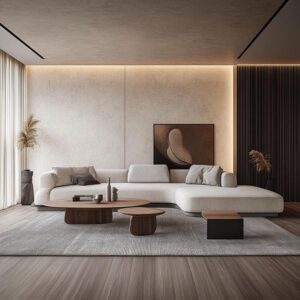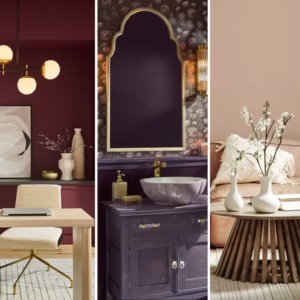This year, designers are betting on a number of emerging trends that are turning the standard living room on its head.
“Living rooms are set to become more personal, more functional, and more formal.”
In 2025, living rooms are set to become more personal, more functional, and more formal. Instead of traditional spaces designed to keep up with fashion, we’re seeing a thoughtful evolution—rooms that blend comfort and art, structure and softness, nostalgia and modernity. Designers are rethinking everything from how we entertain to how we relax, creating spaces that feel like a reflection of the people who live in them.
Expect jewel tones paired with natural textures, sculptural furniture that doubles as art, and designs designed for quiet moments and lively gatherings. Whether it’s a cozy seat by the fire, a recording room designed for personal comfort, or a formal living room revamped for the modern artist, 2025 is all about living rooms that feel layered, inviting, and completely unique. Here’s a closer look at the trends shaping the spaces we live, relax, and connect in.
The formal living room is back.

In recent years, we have seen the return of the formal living room as one of the hottest trends in home design. While spacious and comfortable living rooms used to dominate the scene, there is now a growing interest in reviving the formal and elegant character. The formal living room reflects elegance and sophistication of design, making it the perfect place to relax and entertain guests. Here are some elements and trends that characterize this style.
The formal living room relies heavily on rich and warm colors. Classic colors such as deep red, royal blue, and gold are used to create a sense of luxury. These colors can be combined with neutral colors such as gray and beige to balance the scene and add depth.
The furniture used in formal living rooms often has traditional and classic designs. Sofas with a luxurious appearance, chairs decorated with patterned fabrics, and wooden tables with touches of antique style are the main elements of this style. Furniture pieces with fine details such as carved ornaments or polished wood can be used to add a touch of elegance.
Lighting plays a crucial role in creating a formal and comfortable atmosphere. Using luxurious chandeliers and light pendants that appear under the ceiling can add a touch of luxury. Also, it is preferable to use warm lights to give a sense of warmth and welcome.
Don’t overlook the importance of accessories in a formal living room. Choosing great artistic possessions such as paintings or sculptures adds aesthetic value and depth to the place. You can also use decorative pillows and luxurious carpets to complement the design and add a personal touch to the room.
Attention to detail is what makes a formal living room really stand out. Classic design icons, such as large mirrors, lanterns, and heavy curtains, enhance the overall look of the room and create a general atmosphere of elegance and distinction.
The return of the formal living room is not just a design trend, but an expression of the desire to create pivotal spaces that reflect individuals’ taste and enhance social connections. If you are looking for a design that combines luxury and comfort, the formal living room is the perfect choice.
Solid colors paired with neutrals will be in vogue.

Essential Colors: Power and Elegance
Essential colors are known for their power and ability to add a new dimension to a space. They can be used as a main color to draw attention or as a secondary color to add an exciting touch.
Dark Red: Adds warmth and vitality to a room, making it an ideal choice for decorating walls or furniture.
Royal Blue: Adds a touch of luxury, and can be used in pillows, curtains, or fabrics, enhancing the feeling of comfort and calm.
Emerald Green: Associated with nature and conveys a sense of freshness. It can be used in plants or as a distinctive element in furniture.
Neutral Colors: Solid Foundation
In addition to essential colors, neutral colors, such as gray, beige, and white, play a vital role in the design of the living room.
Grey: It is a modern color and suitable for making essential colors stand out more. It can be used as a background for the room’s walls or in furniture.
Beige: Gives a sense of warmth and comfort, and harmonizes beautifully with essential colors.
White: Makes the space appear more spacious and gives a sense of purity, which helps the core colors to be the focus.
How to combine colors
To create a balanced and harmonious living room, you can follow these tips when combining core colors with neutral colors:
Ratio of use: Use neutral colors for 70-80% of the room, and use core colors as focal points for about 20-30%. This can be achieved through complements such as pillows, rugs, and curtains.
Balanced distribution: Make sure to distribute core colors evenly throughout the room to prevent over-focusing on one area.
Symmetry: Use core colors in recurring elements, such as chair cushions and decorative pieces, as this makes it easier for the eye to get used to the colors.
Add personal touches
The living room is a space that reflects your personal taste, so it is preferable to incorporate personal items, such as artwork, books, and memories, to add a unique touch. Use core colors in these elements to have a strong visual impact.
Soft living rooms – with a touch of elegance

- Pastel colors
Pastel colors such as light pink, sky blue, and mint green are used to create a cozy and warm atmosphere. These colors are not only soothing to the eye, but also add a modern and luxurious touch to the room, making them an ideal choice for living rooms.
- Soft fabrics
Using soft fabrics such as velvet, georgette, or wool enhances the feeling of comfort and luxury. Choose sofas and chairs with luxurious and unconventional fabrics, which increases the appeal of the room and makes it an ideal place to relax.
- Natural lighting
Soft living rooms rely heavily on natural lighting. Use large windows or light curtains to allow natural light to enter. You can also use mirrors to reflect light and make the space appear larger and brighter.
- Furniture with streamlined shapes
Choosing furniture with streamlined lines and natural shapes adds a touch of smoothness and softness to the room. It is preferable to use furniture pieces with rounded corners, which helps create a warm and comfortable atmosphere, and enhances ease of movement in the space.
- Stylish Accessories
Accessories can enhance the aesthetics of a living room. Use decorative pillows, embroidered curtains, and soft rugs to add beautiful touches. Elegant vases and unique decorative pieces enhance the identity of the room and reflect your personal taste.
- Flowers and plants
Introducing natural flowers and plants gives the room vitality and brightness. Choose simple pottery or vases made of natural materials such as wood or stone. These elements are not only aesthetic, but also contribute to improving air quality.
It’s about balancing solidity with softness, expressing opinion with neutrality, in a way that reflects individuality and makes the space look dynamic and real.
Curves are not going anywhere

In the world of furniture design, we witness constant changes that reflect our diverse needs and tastes. One of the most prominent trends that have emerged in the past few years is the use of curves in living room furniture design. Designers have realized that rounded and streamlined shapes add an aesthetic touch and comfort to spaces, and these curves are expected to remain at the forefront of future designs.
Curves in furniture are a sign of beauty and softness. These shapes create a warm and comfortable atmosphere, as they contribute to softening sharp angles and enhancing the sense of comfort. Whether it is sofas, chairs, or tables, curves make the space appear smoother and more elegant.
Curves fit perfectly with a variety of styles, making them a popular choice. Regardless of whether the room design is modern or classic, curved furniture can be used to add a touch of renewal. Curves can also be combined with warm colors or patterned fabrics to create an attractive contrast.
The appeal of curved furniture also lies in the ability of these designs to enhance social interaction. They facilitate movement in the space and allow for better visual communication between individuals. This unique design creates a sense of comfort and openness, making it ideal for living rooms that are used for social gatherings and activities.
Additionally, curved furniture can be used to create focal points in a room. For example, a sofa with a curved shape can become the center of gravity in a room, drawing the eye and stimulating conversation.
Bottom line, it seems that curves are not going away anytime soon. They will continue to adorn living room furniture, providing the warm and aesthetic atmosphere we need in our homes. If you are thinking of updating the design of your room, adopting curved furniture will be a great option to add a touch of elegance and comfort to your space.


